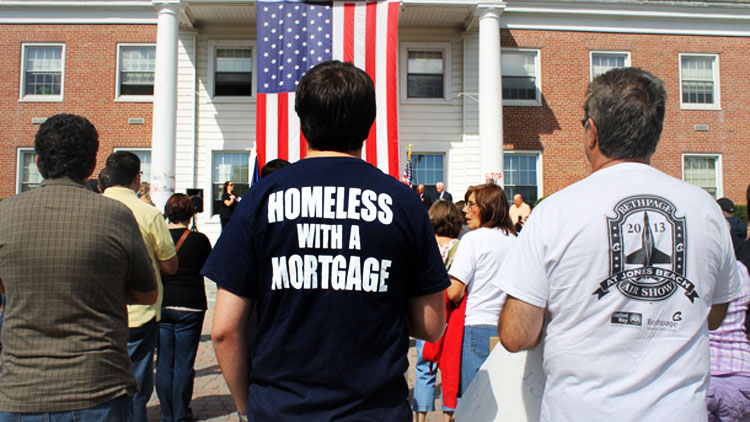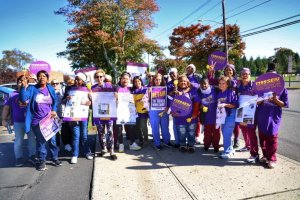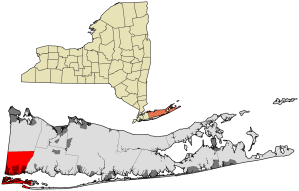A scrum of small business owners huddled with local officials along Freeport’s Nautical Mile one recent Thursday to triumphantly declare that the resilient village had finally risen from the ashes—literally—after Superstorm Sandy had devastated the waterfront community.
Standing alongside these local shop owners was Nassau County Executive Ed Mangano, there to tout the village’s resurrection after Sandy’s record storm surge sent saltwater cascading through the streets, wreaking havoc on the dozens of shops abutting the canal.
That was a year ago this month.
“The message here today is that the Nautical Mile is open for business,” he beamed, a few feet away from where a hurricane-ignited blaze ripped through several businesses on Oct. 29, 2012—the day the superstorm hit.
The county executive—who had walked these and many other battered streets in the days and weeks following Sandy—delivered another message: a hopeful plea for people to return to the Nautical Mile to celebrate its rebirth.
“Many of these businesses got open late in the season and they need your support here,” he continued. “Come on down for dinner, the weather is still nice, the restaurants are beautiful and we all have to do our part.”
As the one-year anniversary of Sandy approaches, Long Islanders across both Nassau and Suffolk counties will look back on the hurricane’s impact on the region and how homeowners and business owners bounced back.
But those effects are still being felt, say local officials and advocacy groups—many of whom continue to have weekly recovery meetings despite all the work that has already been done. They point to the carcinogenic mold continuing to spread menacingly through walls; homes still gutted down to their skeletons because insurance money has yet to arrive; displaced families living in trailers or hotels or small apartments while also paying mortgages; the steady rise in food-pantry visits; more-and-more people seeking treatment for mental health issues related to the storm; and stalled infrastructure projects yet to be completed.
The reality is that thousands who never thought twice about treating their families to a seafood dinner along the Nautical Mile can no longer afford to. Some have depleted their life’s savings and live with the constant fear that things will continue to get worse.
And those on the frontlines with storm-ravaged residents are worried that Long Islanders less-affected by Sandy have already put the devastating storm behind them.
“So many people on Long Island think Sandy was a year ago, it doesn’t matter anymore,” says Richard Schneider, a Red Cross volunteer and Presidential Volunteer Service Award recipient from Merrick. “The fact is that there still are so many that need so much help.”
LIVING WITH SANDY
Pattie and Victor Calcano had just finished up Tropical Storm Irene-related repairs on their Berger Avenue home in Amityville when Sandy barreled into LI.
The storm swallowed their home and forced the Calcanos to level the entire house and replace it with a two-bedroom trailer that they’ve been living in with their three children ever since.
“It’s just basically holy hell,” Pattie says with a tired laugh.
The loss of their home has been made harder by the ongoing battle with their insurance company. The Calcanos have also been forced to shell out a $30,000 rental fee for the trailer while also paying for a mortgage on a house that technically doesn’t even exist. Thus, their savings account has dried up.
After what they had gone through with Irene, Pattie was sure they’d be able to do all their repairs by June. But the miniscule amount of insurance money they received compared to what they could get didn’t even start trickling in until then, forcing them to postpone repairs.
“People say, ‘How are you doing?’ says Victor. “You’re tired of saying ‘horrible.’”
Their story is all too common in a post-Sandy Long Island.
Debbie Lemaire and her family picked up a Christmas tree last December and plopped it inside their small hotel room they had been living in since Sandy poured 46 inches of saltwater mixed with a toxic blend of oil and sewage into their Lindenhurst home.
The entire house was gutted, forcing them to seek shelter elsewhere. The Lemaires are now living in Wantagh, where they pay $2,700 a month on top of the existing mortgage on their South 8th Street home.
“Even people in the same neighborhoods don’t see [that Sandy still exists],” she says softly. “Support your neighbor and help us cut through this red tape. We paid the insurance premiums for 30 years. God bless the people who didn’t have insurance, they got their money, they made the repairs, they’re back.”
WHERE’S THE MONEY?
Three months after Hurricane Sandy battered the Northeast Congress finally approved a $60 billion aid package to help pay for the storm. Yet nearly one-year later, much of that money has yet to make it into the hands of homeowners and local municipalities who need the cash the most, say local officials and residents.
“No funding has come to us yet,” blasts Mastic Beach Village Mayor Bill Biondi. “We’re still waiting for the governor to release the money that’s supposed to be coming to us.”
Mastic Beach, which still has around 75 homes deemed uninhabitable and 12 that have been lifted, was one of the hardest-hit areas in Suffolk County, thanks to a breach in Westhampton Beach and two more breaches on Fire Island, which acts as a barrier for coastal communities to its north.
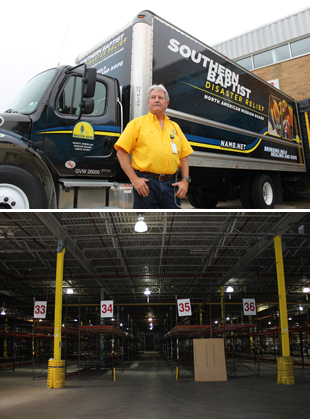
Federal aid will handle the $700 million cost of a half-century-old Fire Island to Montauk Point storm mitigation project plan that is supposed to strengthen 83 miles of shoreline and would calm fears in communities such as Mastic Beach that a storm surge would torpedo through unabated like it did during Sandy. The hurricane has overcome the plan’s biggest hurdle—funding—but rebuilding barrier island dunes is not slated to start until January, with raising thousands of South Shore homes on stilts to come later.
Biondi says he walks into his office every day hoping to find a letter or a voicemail telling him money is on its way.
“I never thought here in the United States people would still be waiting, a year later,” he adds.
But the state insists projects are in the works.
In September, 21 communities from South Valley Stream to Mastic Beach began meetings under the New York Rising Community Reconstruction Program, which puts the onus on these towns and villages to come up with their own unique plans to strengthen their communities. Their plans have to be submitted by April 2014 in order to receive a slice of the $750 million Gov. Andrew Cuomo has allocated for the projects.
Babylon Town Supervisor Rich Schaffer says the town received federal aid for emergency work done during and after Sandy, but acknowledges that homeowners will have to hold on a little longer until New York Rising is completed.
“[We] still have a number of people who are not home who don’t have a clear answer as to how they’re going to get home,” he says. “That’s my biggest concern. We need these programs to move quicker.”
According to state data, $266,148,756 in public assistance funding from the federal aid package has been dispersed to LI, though mostly for emergency work following the storm. Nassau County says residents have received $323,768,556 for individual assistance.
“Nassau County continues to recover and rebuild from the damaging impact of Hurricane Sandy,” Mangano said in a statement to the Press. “We continue to fight to get residents the Federal dollars they need to rebuild their lives.”
Suffolk County Executive Steve Bellone was not made available for comment. The county also didn’t respond to a list of questions for this story.
Several residents still struggling to get back on their feet put the blame on the federal government. They say local officials are handcuffed and can only do so much.
“It’s still not done and it’s a year,” Lindenhurst-native Joan Ensulo says of repairs to her home because the Federal Emergency Management Agency (FEMA) declined her application for funding. “And I’m not half as bad as half of all these people with children who are not in their homes and homes who had to be lifted.”
Bayville is the only North Shore village among the 21 communities under New York Rising. Its mayor, Doug Watson, is doing what he can to help residents in the meantime, but he understands why residents are upset.
“We are forging ahead at the speed of government,” he says, with a hint of sarcasm.
CATASTROPHIC FAILURE
Local government hasn’t been taken off the hook entirely.
In Nassau, residents living near the Bay Park Sewage Treatment Plant have derided lawmakers for delaying most of the $722 million in borrowing requested by Mangano—$262 million of that has been approved—after the Sandy storm surge led to a catastrophic failure at the plant, spewing sewage into streets, waterways and homes.
A man who lives near the plant blasted the 19-member legislature at a recent meeting, accusing them of playing politics with residents’ lives, and admitting to “foolishly” believing lawmakers would come to a deal that would fix the plant and finally put an end to what he called “Sunday smell”—an obnoxious odor which disappeared last summer but returned after Sandy.
“For God’s sake, fix my problem,” he said, adding, “Sooner or later your going to kill this community, [and] you’re going to have a lynch mob on your hands.”
Republicans have a 10-9 majority in the county legislature, but need a supermajority of 13 votes to approve borrowing. Democrats have argued for more oversight before approving hundreds of millions of dollars that would add to the county’s mounting debt load. FEMA is expected to pick up the tab but only after the county already borrows the money for the repairs.
“After investing $70 million in upgrades to the plants, Hurricane Sandy created further damage,” Mangano said in a statement. “The time is now for Democrat legislators to lay politics aside and partner with me in creating a state-of-the-art environmentally friendly facility that protects both our residents and local waterways.”
Bay Park isn’t the only major facility that suffered critical damage during the storm.
Long Beach Medical Center is the last remaining major hospitality yet to reopen since Sandy. The entire basement—basically the center of the hospital’s operating system—suffered major flooding and the hospital has yet to recover.
“There wasn’t anything you needed to run a hospital that probably wasn’t included in the basement,” says LBMC spokeswoman Sharon Player.
Thousands living on the barrier island have signed a petition pleading with the state to step in to get the hospital back and running, fearful of what could happen without an emergency facility on the island.
But it appears the 162-bed hospital—down from 200 at its peak—was in dire straights economically even before the storm, making the medical center a good candidate to merge with another facility on the South Shore, possibly South Nassau Community Hospital.
“The medical center had been losing money, we are a hospital that serves a lot of Medicare and Medicaid patients,” Player says. “We don’t look at it as a bad eye to be serving people who are struggling.”
Player declined to go into detail regarding a potential merger, citing a non-disclosure agreement. LBMC lost $2 million in 2011, she notes. Figures for 2012 aren’t available because Sandy struck before the end of the year.
Still, the LBMC has done what it can to continue providing treatment to residents, specifically in mental health because many suffered deep, emotional scars that came to the forefront in the months after the storm. Others also joined in the effort to aid Long Islanders battling inner demons.
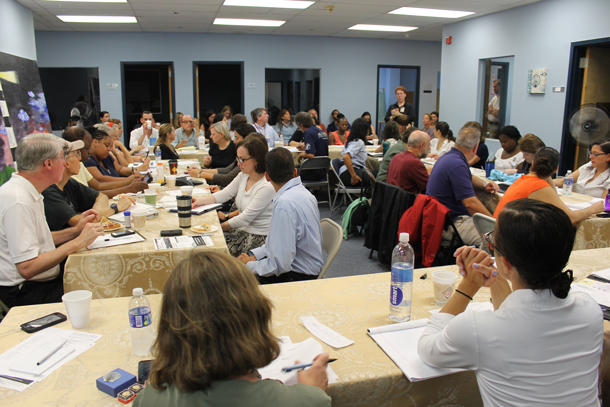
Inner Struggle
“The ongoing cost and the increased debt that’s coming for folks that were already struggling is really a story that’s not getting covered,” says Gwen O’Shea, CEO and president of Health & Welfare Council of Long Island, and who has also been leading efforts at the Long Island Volunteer Center, which just recently moved out of a cavernous warehouse in Bethpage that the furniture company Sleepy’s provided to her and dozens of other charities, for free. Mental health, she adds, is “falling under the radar…And we have serious concerns when the anniversary does hit, what are the implications going to be for people from a physical and mental health perspective?”
“Can you imagine having three kids, working a full-time job, taking care of your elderly parent and trying to keep it all together for 10 months, 11 months?” she adds.
Mental health experts point to the stress of rebuilding and the financial struggle that befell many Sandy survivors as evidence why mental health treatment is critical in preventing people from falling into a black hole that they’ll never climb out of.
But some people may be too proud—especially former breadwinners, who never experienced a problem this devastating—to ask for help.
“People don’t expect tragedy to happen,” says Robyn Berger, division director of Huntington-based Family Service League. “And when it does, it’s very hard to move forward without someone to help you through it, particularly if you’re somebody whose never needed help in the past.”
Children, too, have also developed mental scars that require treatment, says Colleen Merlo, associate director of the Mental Health Association. Some are even showing signs of Post Traumatic Stress Disorder, she says, adding that the slightest rainstorm can awaken horrific memories from last year.
“Children’s mental health was severely impacted,” by the storm, notes Merlo, adding that she expects her phones to be flooded with more calls from concerned parents.
The ongoing mental health crisis would be far more severe if it wasn’t for nonprofit organizations and other mental health treatment facilities that have gone door-to-door to check up on patients or lend a helping hand. A number of other groups, such as the Red Cross, The Health & Welfare Council, United Way of Long Island, and even charities from thousands of miles away have contributed in any way they can.
“I think so many peoples lives…are back to normal, and unless you go—if you’re out on Long Beach, you could still see destruction,” says Bill Johnson, Southern Baptist Disaster Relief North American Mission Board project coordinator and volunteer, who came all the way from Kentucky to help and has been here ever since. “But in so many of these areas, like in Island Park, or in Freeport, if you go down by the water, you’ll see a roll-off there that people are still putting stuff in, but outwardly, it doesn’t look that bad. But when you start looking inside, there’s still so many people that’s not back together.”
FIGHT ON
A camera is slung over Lance Walker’s neck as he makes his way through a crowd of people outside Babylon Town Hall on Sept. 28. He cuts through, holding signs declaring “Stop FEMA Now!” and asking, “Where is our money?”
Walker, one of the subjects of the Press’ Sandy coverage last year, was smiling as he walked—a hopeful glow radiating around him.
Last time we spoke, Walker was standing outside his Lindenhurst home, which just had been ravaged by Sandy’s storm surge. His eyes welled with tears as he grabbed a hold of his children, wondering if he’d ever be able to watch home videos of his kids growing up. It turned out he wouldn’t, the saltwater took care of that.
But things are improving. Walker is back in his home after living in two apartments since the storm, and his home is 80-percent recovered, he says proudly.
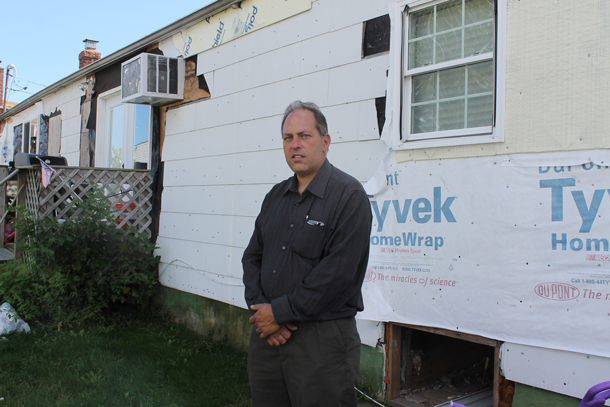
“It’s been a long road but we’ve come a long way,” Walker says.
As he continues to rebuild his Shore Road home, Walker admits that he’s in a better place than immediately after the storm. He has more hope because of the support of total strangers when he was at his worst.
“After the storm you realize how good people were,” he says. “I walked around for a couple of days without any shoes on, and somebody heard about it, and I had six pairs of brand new shoes…I’m actually more hopeful now.”
The year of torture that thousands on Long Island lived through has many people feeling less optimistic about the future. Things won’t get better until insurance companies unload more money and federal aid dollars start trickling down. Much of Long Island is still a broken puzzle board, with pieces strewn about. But there is hope.
Walker, who has been to hell and back, is moving forward with newfound resilience that has him more hopeful than ever.
“[Sandy] does still exist,” he says. “It’s a long process but we’re all learning from it. We’re meeting new friends. We’re finding out that there are people who really care and besides all the bureaucracy, we’ll get through it.”
“Don’t walk away,” he adds, “don’t give up, just hang in there, it’s worth it. It’s worth it.”



